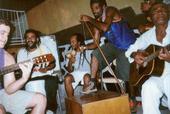Parang is derived from the Spanish word parranda which means "the action of merry making, group of serenaders." Parang is usually associated with Christmas festivities. Traditionally the parrandero, which refers to the singers and the instrumentalists, travelled from house-to-house in the community and was often joined by friends and neighbors using whatever instruments at hand (usually string instruments), including violin, guitar, claves (locally known as toc-toc), box bass (an indigenous instrument), flute, mandolin, bandolin, caja (a percussive box instrument), and marimbola (an Afro-Venezuelan influence). In exchange for the entertainment, traditional parranderos would be given food and drink rum or ponche de creme (an alcoholic eggnog). It is typically played with cuatro (a four-string small guitar), maracas (locally known as shak-shaks), and is often sung in Spanish.
Although it is much less common in modern times, musicians called Parranderos still roam the streets playing this music and serenading people with both sacred and non-sacred repertoire. Song types include the aguinaldo (relating to the stories of the Nativity or birth of Christ), guarapo (more secular and the content/length of the song varies according to the preference of the lead singer and his skill of developing rhyming verses), estribillo (a sing along song which is very lively and is sang in a call and answer fashion), manzanares (a Venezuelan waltz which celebrates the different aspects of the Manzanare river of Cumana, Venezuela), joropo (a song whose style is similar to the Spanish waltz), galerón, picón, serenal (a song in which the parranderos state their arrival and seek to enter one's house), and despedida (usually the last or farewell song which is sang by the panderros when they are about to leave one's home or when they are about to pause). Although the repertoire is influenced by nearby Venezuela's traditions, it has largely developed into an indigenous performance genre in Trinidad. While the traditional house-to-house caroling tradition is still practiced by small groups and larger organized groups, the music has also developed into a season of staged performances called "parang fiestas," held from October through January each year, culminating in a final national parang competition.
The origins of the presence of parang music in Trinidad and Tobago is controversial. There are two theories which describe how parang music may have came about in Trinidad and Tobago. The first theory is that Spanish monks who were present in Trinidad to lecture people about Catholicism were the first individuals to introduce the music which is now known as parang. The second theory is that Venezuelans brought the first elements of parang with them when they migrated to Trinidad to escape the Bolivian Revolution.
Notable parang 'bands' and artists include Daisy Voisin, Henry Perreira, Sharlene Flores, Leon Caldero,Lara Brothers, Los Tocadores, Los Parranderos de UWI, Los Alumnos de San Juan and Del Caribe.
As the genre popularized since the 1950s, parang has evolved and many soca music artists have generated a cross-over music called "soca parang" which is a fusion of calypso and soca whose lyrics are sang in English and are inspired by the "Americanized" Christmas often referring to such symbols as Santa Claus. Noted parang-soca artists include Scrunter, Crazy and Big B. Chutney (a singing artform of the indigenous people of Trinidad which have influences from Indian rhythms and are someitmes sung in Hindi) melodies have also been fused in with Parang and there are even parang versions of Latin hit songs which have been created in recent years.
The practice of paranging remains an important element of not only the Trinidadian rituals during the Christmas season but also in the rituals of other islands such as Grenada and the Dominican Republic and other countries such as Venezuela. Parang is especially vibrant in Trinidad & Tobago communities such as Paramin, Lopinot and Arima
